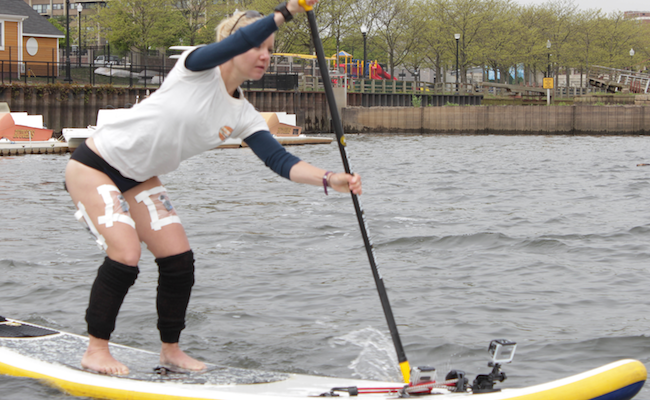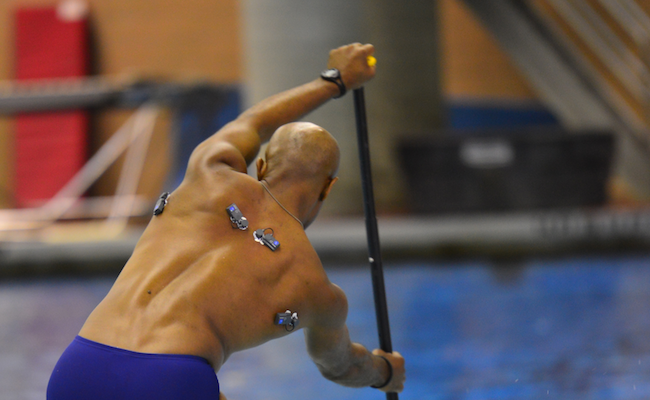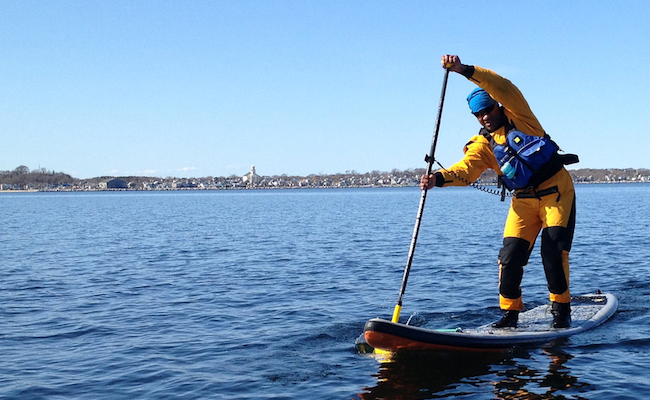SUPLogix Research Combines Science & SUP
- Written by Staff
- Published in News
- Comments::DISQUS_COMMENTS
NEWARK, New Jersey - Meet Shannon MacDowell and Carey Bond, a pair of highly intelligent paddlers who've put their heads together and started something very cool. In 2013 they founded SUPlogix, an initiative that "was created to contribute to the progression of stand up paddle boarding through scientific study, instruction, product design, community outreach and promotion of the health and fitness benefits of the sport." One of their most interesting projects is the first electromyography study of stand up paddle boarding - tracking the electrical activity generated when muscles contract - while paddling. This is being conducted in conjunction with BTS Bioengineering and Rutgers University, where Shannon got her BFA. The video below is what initially piqued our curiosity and this week we were lucky enough to catch up with Shannon to find out more about SUPLogix and the work they're doing…
1) When/how did the idea to study the biomechanics of stand up paddle boarding come about, and how did you manage to pitch it to the university?
Both Carey and I have extensive fitness industry credentials in addition to our paddling backgrounds. We utilize our knowledge of biomechanics, training, and kinesiology when we are instructing or coaching as well as in our own paddling. We can get really nerdy sometimes.
 Shannon paddling while connected to the wireless EMG trechnology
Shannon paddling while connected to the wireless EMG trechnology
Teaching literally thousands of SUP paddlers in a major urban market and watching SUP grow so rapidly, we felt it was time to take a scientific look at sport. We’re all experiencing the full body benefits of SUP - Carey and I thought it would be great to back up this all up with some objective data and learn more about what’s actually going on in SUP paddling.
Because of our backgrounds, we were aware of some of the most effective ways to measure and analyze human movement and muscle activity. We realized that electromyography (EMG), which has been used to study dance, other endurance sports like cycling, and physical therapy, would be a good fit. Our goal was to take a look at SUP in the most real world way possible- not in a laboratory.
Through our research we came across BTS Bioengineering (www.btsbioengineering.com), which had exactly what we were looking for. BTS has pioneered a wireless EMG technology with a range of up to 50 meters, which is perfect for studying on-water paddling. We got in touch with COO of BTS, Davide Ferrario, and he was immediately on board- no pun intended.

Once we had the technology, we needed an indoor and outdoor location to conduct phase one of the study. This is when the light bulb turned on! I am a Rutgers alumnus, and Rutgers is an established research university….. who happens to have an Olympic size swimming pool and a boathouse on the Raritan River. I reached out to some professors and deans at the school, who directed me to the aquatics and recreation departments. Everyone was super stoked about the study and building a SUP program at the school.
2) How does the process work and what does the data you capture offer both paddlers and instructors?
This technology is really cool. You first decide what areas and muscles of the body you want to study. Electrodes are then placed on the belly of individual muscles. Probes attached to the electrodes record EMG signals and transmit them to a computer that displays immediate feedback of the electrical activity in the muscles. It basically shows you how hard the muscles are working. You can place up to 16 channels at a time, which allows you to compare activity across a range of muscle groups. The awesome thing about BTS software is that it can present the information in real time, which is an incredible biofeedback tool.
When you see what muscles are working, that’s an invaluable window into what constitutes efficient paddling. Correlating actual objective muscle use with other factors like speed, cadence, heart rate and perceived exertion, you have information that is truly accurate in terms of how to move a board well.
From a teaching standpoint, it gives you the ability to tell your students directly and specifically how they should be using their body and focusing their mental energy. On the performance side as we know, every little bit helps. This data is hugely beneficial in terms of optimizing one’s ability as a paddler. This includes injury-prevention methods and off the water training. Phase two of the study is going to include elite athletes, that’s where it’s going to get REALLY interesting.
 Carey Bonds
Carey Bonds
3) Have there been any interesting or unusual findings?
All of it is pretty exciting simply because it’s never been measured for SUP before. I think what’s interesting, and you see this in other sports, is that there are some basic principals that work well across the board. For example with paddling, using large and core muscles generates sustainable, efficient force. But after that, the data showed that it really starts to become individualized. That’s what so important about all of this. What might work really well for one paddler, might not for another.
4) How have students and faculty responded to you introducing/working SUP to the outdoor Recreation Department at Rutgers?
Working with the Outdoor Recreation Department at Rutgers is a total blast. SUP is so hot right now, everyone wants to try it out- undergrad, grad, faculty, swimmers who were suppose to be paying attention to their practice…. we were definitely occupying the pool in a way that everyone wanted to join in. I think it’s just so much fun, the stoke is contagious.
5) It looks like you had a very successful first year with the program and in 2014 you're expanding the program at Rutgers. Can you tell us a bit about what's in store for this year?
We definitely had a great time introducing the SUP program at Rutgers this fall. There are several fun directions we’re looking to expand in 2014/15. Continuing the pool program, building the outdoor component, and setting up away adventure trips. Yoga on the board is really big right now. With my Pilates background, I’m developing a Liquid Pilates program that is super fun and excellent for building core strength and preventing injury.
I’ve been watching the Sochi Olympic Games- Olympic skier Julia Mancuso talked about how she uses SUP as supplemental training in a recent Wall Street Journal article. The word is out. I would be psyched to get some of the varsity sports teams involved in the SUP program. Anything that builds balance and proprioceptive awareness, in addition to strength and cardiovascular endurance, without any impact, is fantastic cross training.
6) Is there room for a degree in SUP studies?
I wish! But seriously yes- firstly I don’t think I’m overstepping by saying that the way the sport is evolving, SUP should be an Olympic sport. Additionally, SUP is emerging as a great therapeutic modality. So whether it’s performance, injury prevention or rehab, a degree in SUP studies is not that far fetched! Dialing it back, there is no question that SUP teaching and coaching certifications that address the full picture and potential along with the kind of data that we’re producing should be on the near horizon. We would like to have something to do with that.
© Copyrighted & Exclusive SupConnect.com Content.

Staff
Submit your news, events, and all SUP info, so we can keep promoting and driving the great lifestyle of stand up paddling, building its community, and introducing people to healthier living.
Website: supconnect.com Email This email address is being protected from spambots. You need JavaScript enabled to view it.




